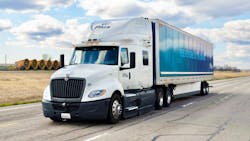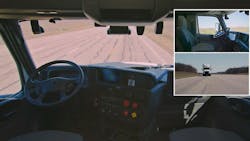Another autonomous trucking tech pioneer has tested whether its system can replace human truck drivers.
Plus announced that its Level 4 autonomous virtual driver completed its first totally driverless validation tests on a closed track. Its virtual driver, SuperDrive, flawlessly performed maneuvers on a high-speed test track in East Liberty, Ohio, its leaders said.
“Nothing went wrong. It was totally smooth, and it was amazing,” Tim Daly, chief architect at Plus, said.
The validation testing is another step in the march of autonomous trucking companies toward widespread commercial use.
“Our industry is at an inflection point,” David Liu, Plus CEO and co-founder, said. He called autonomous vehicles one of the most important applications of the AI revolution.
See also: Fleets Explained: Autonomous vehicles
Passing the test
Software redundancies guarantee safety
A virtual driver must autonomously operate under countless conditions, including different geographies, weather conditions, traffic conditions, and more. It is no small feat for a system to make quick observations and safe decisions under those various situations.
Plus’s virtual driver uses machine learning architectures to identify objects, predict their movement, and make high-level driving decisions. It also employs a simpler, rule-based system as a redundancy to establish human driving standards.
If the virtual driver encounters significant problems, a fallback computer takes over to maneuver the vehicle to a safe stop.
Plus’s SuperDrive is no stranger to the 7.5-mile test track in Ohio. The company often runs validation tests when it updates its virtual driver software—but “this is the first time we’ve done operations with literally nobody in the truck,” Daly said.
The operations included several maneuvers and conditions to challenge the driver’s autonomous capabilities. The tests included pulling over to the shoulder, safe stops, simulated device failures, and more.
The testing utilized International trucks equipped with SuperDrive. The trucks used various powertrains and hauled empty, half-loaded, and full trailers.
According to Daly, the driverless run was a total success.
“What was even more gratifying was how quickly it became mundane. The system was predictable; it didn’t do anything unexpected,” Daly said. “It felt very safe.”
He said that this is the first of many driver-out runs that the company will observe before taking driverless operations to public roads and commercial scaling.
The future of transportation
Autonomous trucking is approaching. Commercial operations like robotaxis are growing, and regulations are warming up to autonomous driving. Rapid technological advancements are also bringing autonomous trucks closer: Liu pointed to continued improvements in machine learning and computing power.
While autonomous trucking companies promise that AI won’t replace drivers, they are also quick to point to the potential cost savings of driverless trucks. Drivers are the greatest per-mile operational cost for motor carriers and are susceptible to unsafe behaviors like distracted driving. In addition, autonomous drivers can significantly improve energy efficiency. Liu said that autonomous trucking could reduce operational costs per truck by about 48%.
“That’s a huge cost saving in an industry that’s $2 trillion in size and where margins are very, very low,” Liu said. “The entire industry is waiting for this to happen.”
SuperDrive is already moving pilot loads in Texas, joining other autonomous trucking companies in hub-to-hub hauls among Dallas, Houston, and San Antonio. And like other major autonomous trucking companies, Plus hopes to be ready for commercialization in 2027.
“2025 is about validation," Liu said. "Next year is about getting to commercial readiness, where we start conducting some driver-out pilots and operation pilots in 2026, and then we’re looking at doing commercial launch and scaling in 2027.”
About the Author
Jeremy Wolfe
Editor
Editor Jeremy Wolfe joined the FleetOwner team in February 2024. He graduated from the University of Wisconsin-Stevens Point with majors in English and Philosophy. He previously served as Editor for Endeavor Business Media's Water Group publications.


